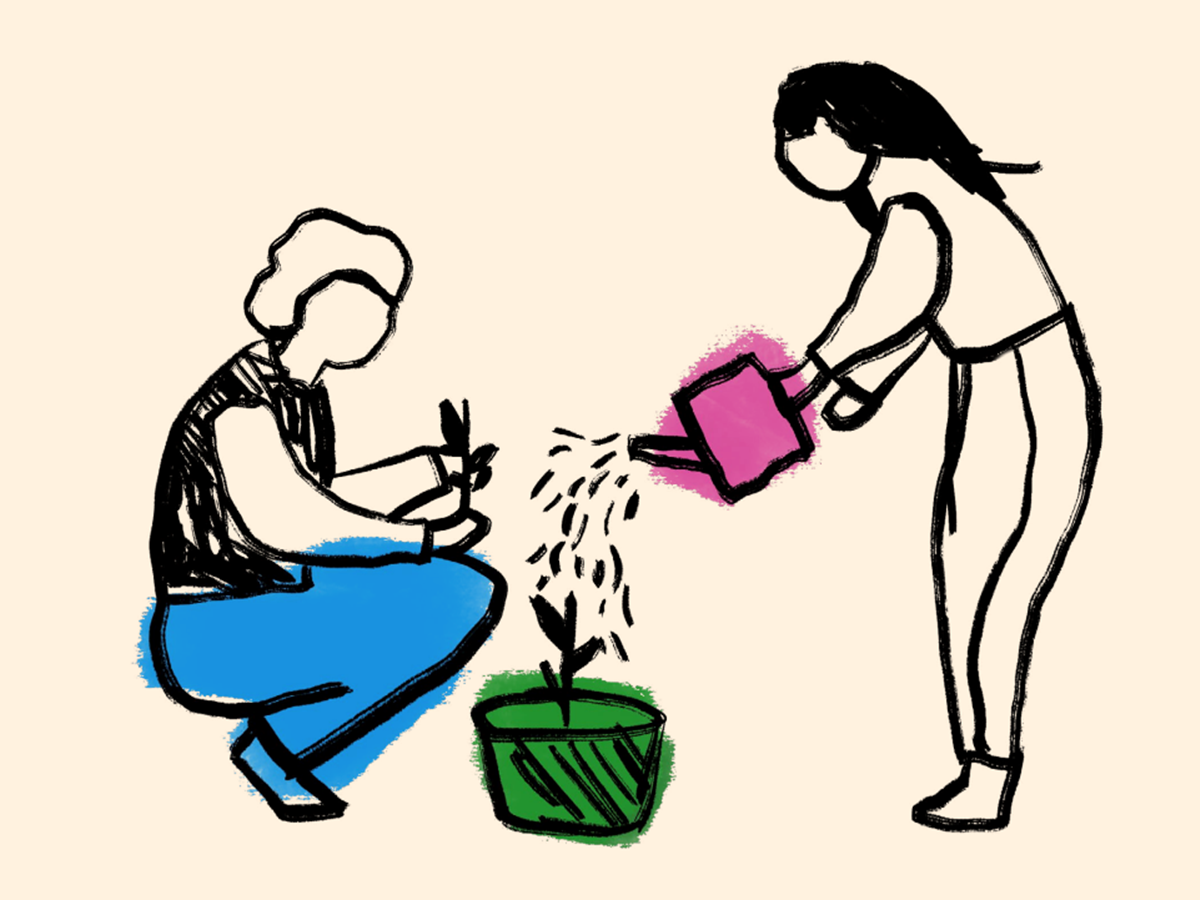Bios:
Alex Johnston is a transformative justice practitioner who specialises in applying transformative justice (tj) and abolitionist principles in the context of schools and youth organisations, they are based in London.
Latifa Akay is a writer, producer and facilitator and supports groups and collectives to build collective care practices and processes in her role at Act Build Change. She is currently supporting youth organisations and groups working around the hostile environment to reimagine safety and safeguarding. Latifa formerly worked as Director of Education at Maslaha.
Latifa: I’m thinking back to when we started writing the workbook and we were in that inception stage where we had far too many working documents and a lot of ideas floating around. At the time I was safeguarding lead at the charity Maslaha and was at a loss to find any kind of safeguarding training for myself and colleagues that didn’t end up profiling and pathologising young people of colour.
I remember my colleagues Shaheen and Alaa going on training that we hoped would be a bit different, and they came back with a depressing list of the ways that the training had been heavily racialised. We could see from our work with young people that the red alert around particular ‘safeguarding issues’ for particular racialised communities, e.g., ‘honour-based violence’ and South Asian girls, FGM and Somali girls, knife crime and Black boys – meant that the young people themselves were being overlooked and let down. In the case of ‘honour-based violence’ and South Asian girls for example, issues that might be more effectively addressed as other forms of abuse – or in the context of conversations on healthy relationships, boundaries and consent – will often be quickly assumed to be ‘honour-based violence’. In instances like this, the impulse (we’ll come to that later) to follow the racialised risk indicator overwhelms the capacity or desire to see the young person in the full context of their personhood.
At that stage I was talking to different people about what alternative approaches to safeguarding could look like – approaches that would seriously consider and prioritise what safety could actually mean in the context of different young people’s lives. An approach that therefore would consider racism, homophobia, Islamophobia, transphobia, ableism etc. – all issues that hugely affect the safety and psychological and physical wellbeing of young people - as safeguarding issues. I was looking for someone who had experience in exploring transformative justice approaches to considering safety for young people - and I was introduced to you [Alex]. I’ll let you explain what transformative justice is, and how the work of CSN supported us in exploring ways that could be practically applied.
Alex: ‘Transformative justice’ (tj) is a term used to describe approaches to justice rooted in prison abolition. A crucial part of this work is to build alternatives to the systems that uphold prisons - including policing, state surveillance and the criminal ‘justice’ system. This work begins by acknowledging that we don’t yet have what we need, and we don’t yet know the answers.
The logic of prisons (the ‘carceral’ logic) says that punishing people will change their behaviour which is demonstrably untrue.
Transforming our conceptions of justice means turning away from both this logic and from the cycles of violence perpetuated by it. The question of tj is: How can we support people to change their harmful behaviour without causing more harm? In fact, because tj is concerned with building what we don't already have, transformative practice begins with a lot of questions, for example: How do we define harm, without criminalising behaviours? What were the conditions within which the harm occurred, and how can they be transformed so as to prevent harm from reoccurring? What were the earlier intervention points, what could have been done, and by whom? What are the conditions required for someone to meaningfully move away from behaving in harmful ways and how do we create them?
These questions demonstrate that transforming harm requires confronting the context around that harm - transformative work is contextual work.
When we began creating the workbook, I had in mind GenerationFIVE’s Ending Child Sexual Abuse - A Transformative Justice Handbook. It encourages us to confront the ways in which cultures that enable child sexual abuse are perpetuated and how to both transform these cultures and respond better as a community when we see harm occurring. It seemed a very natural progression to me to expand this to the safety of children and young people more broadly and in the context of schooling and safeguarding.
The work of the CSN set precedent for the value in a broader, systemic approach to harm. Both tj and contextual safeguarding are concerned with the factors at play in enabling harm, and the work of CSN gave us practical tools to support practitioners to see things differently, including the ways in which some safeguarding practices perpetuate the cycles of harm you described above. CSN’s ‘relationships of trust vs relationships of surveillance’ framing in particular, really stood out to us - do you want to talk a little bit about that?
Latifa: Yes, a key starting point for thinking about surveillance in safeguarding is that any hope to avoid surveillance in safeguarding has to be completely intentional because the purpose of state ‘safeguarding’ is to profile. For the state, safeguarding and surveillance are pretty much synonymous.
Making a shift towards rejecting surveillance within this system requires constant vigilance and consideration which is why CSN’s ‘relationships of trust or relationships of surveillance’ tool is so critical. It offers very practical indicators to practitioners to identify the ways that ‘safeguarding’ can slide into surveillance. I’ve used this tool in different contexts since we created the workbook and it never fails to resonate with groups around how safeguarding culture so often just slides into ‘surveillance’ and becomes more about safeguarding institutional reputation than the people in their charge.
One element of this tool that really stood out to us in the ‘how’ of ‘building relationships of trust’ is that practitioners should be confident and ‘open to uncertainty and complexity.’ This brings me to what you were saying about ‘transformative practice beginning with questions’ - this was something that you constantly brought to the process of shaping the workbook that I really valued, and it accounts for the fact that we include so many questions in the workbook!
Sitting in uncertainty can often feel unbearable, particularly when the stakes of safeguarding feel so high. Practitioners will often talk about fear in relation to safeguarding, which is completely understandable - the fear of harm coming to someone you are supposed to be responsible for, and fear of being guilty of ‘making the wrong decision.’
Sitting in uncertainty is scary because it means stepping off the well-trodden path - this is the essence of what radical safeguarding is. If practitioners are moving constantly from an ‘outcome driven’ place in safeguarding we know that they will almost certainly be making decisions based on profiling, stereotyping and assumption - fulfilling the design of much safeguarding as an arm of state policing - think about the Prevent policy and Muslim communities, for example.
But we know that the invitation to ‘sit with uncertainty’ isn’t a neutral one. Towards the end of last year I delivered a series of ‘Reimagining Safety’ workshops with Ameen Kamlana and Farah Elahi to a wonderful group of health practitioners as part of Healing Justice’s ‘Movement Medicine’ series. In one of these conversations a participant spoke about how it is often those with the most power - e.g. a white male consultant - who will be able to say: “okay, I’m going to make a decision differently”. The stakes for him will always be lower than for someone with less positional power e.g. a nurse who is also Black and a woman. We know that ‘accountability’ isn’t neutral territory - and that often those held ‘accountable’ will be those with less power or those seen in some way as disposable. In these conversations this brought us to the power of the collective. It will often not be enough to say – “okay, we all just need to individually sit with uncertainty and feel confident to shoulder the ‘risk’ of making different choices”.
I’ve been working with groups who are exploring what scaffolding they can put in place to create systems so that safeguarding can become more of a collective responsibility rather than an individual one. This work gives me a lot of hope because not only does the prospect of making collective decisions create scope for more considered and less fear-based decisions - but it also serves as a check and balance to the assumptions and bias (bolstered by societal stereotypes that are baked into safeguarding guidance) that individual practitioners will have. Every one of us makes assumptions in different ways - by acknowledging that this is the case and that actually because of this we need to create spaces for collective thinking and reflection, we can approach safeguarding in a much more generative way.
Alex: Yes, exactly. In the context of schools, for example, punitive and risk-based approaches in mainstream safeguarding might mean that a headteacher or safeguarding lead feels as though all the responsibility for each child’s wellbeing actually comes down to them and their individual decision making. But, in the real-world context, every child sits within a web of relationships and it is the quality of those relationships that support their safety. I love that contextual safeguarding makes room for the protective factors that are already in place, sometimes put in place by the child or young person themselves (for example - intentional lateness to school can be a protective choice), and in schools we have to acknowledge that it is risky for some families to be open with schools about what’s going on for them if there is a known history of schools ‘reporting’ families to the state. This makes me think of Leona Vaughn’s concept of ‘tolerable harm’ vs ‘intolerable harm’ which we draw on in the workbook, and the ways in which each practitioner is making a call about whether the harm caused by an intervention, for example reporting as part of Prevent, is more tolerable to them than the risk of another potential harm (and often, as you mention above, the risk to their own reputation). Positionality also plays out here: who is allowed to tolerate, and who is allowed to tolerate what?
For me what’s been exciting is an opportunity to name and pay attention to the relationships at the heart of safeguarding, not only between practitioners and those they work with, but also between practitioners. Tj work is about working with what we already have to transform culture, and not about top-down decisions or outsourcing responsibility.
The question I’ve been asking myself recently in my work with schools is: Where are the strong relationships at play in what we’re trying to transform and how can those relationships carry the labour? Where is there trust, and where does it need to be? What relationships need to be invested in? In that way, part of distributing the power and the risk of radical practice in institutions with safeguarding responsibilities can be about strengthening relationships between safeguarding practitioners across an institution (and between institutions), so that they can move into interdependence and avoid the burden falling to those who are in more precarious positions.
The Radical Safeguarding Handbook is available here.
Title illustration by Soofiya https://www.soofiya.com/
Cited resources:
GenerationFIVE’s Ending Child Sexual Abuse - A Transformative Justice Handbook is here.
For further information on Prevent policy and Muslim communities see here and here.
Information about Healing Justice and their Movement Medicine series is here.
Leona Vaughn’s concept of ‘tolerable harm’ vs ‘intolerable harm’ appears in her PhD thesis, ‘Doing Risk’: Practitioner Interpretations of Risk of Childhood Radicalisation and the Implementation of the HM Government PREVENT Duty, which is here.


